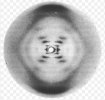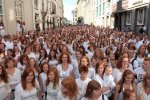Loxuru
Graf von Kreuzigung
Hear no complaints, see no complaints, speak no complaints!You can't see the fine print, and he can't hear the fine print.
If I agree not to speak the fine print then we're the Three Wise Monkeys

Hear no complaints, see no complaints, speak no complaints!You can't see the fine print, and he can't hear the fine print.
If I agree not to speak the fine print then we're the Three Wise Monkeys
A great achievement of Franklin. These X-ray diffraction records of those days were difficult to interpret.February 28th 1953: James D. Watson and Francis H.C. Crick announced in Cambridge that they had determined the double-helix structure of DNA, the molecule containing human genes. Their failure to credit Rosalind Franklin (whose x-ray photo confirming their theory had been shown to them without her knowledge) was despicable, the credit certainly belonged to all three, and to others who'd contributed too. Still, an epoch-making discovery in the history of life sciences.

You mean these lovely ladies?Happy St Patrick's Day to all our Irish friends (and their redhead wives too, of course)
View attachment 1286570


Oh hell yes - bring 'em to me now!

A 'Red State'?

Ummm.... we'll need a bigger bus.Oh hell yes - bring 'em to me now!

I'll trade my red state for that red state in a heartbeat.A 'Red State'?

Even though one could argue resistance was futile, it gives dignity to the victims to know that people fought back. (It is also noteworthy that despite rampant antisemitism in Catholic Poland the Polish Resistance aided the ghetto.) There were several groups of Jews (notably the Bielski partisans) who went into the forests in Poland an Belarus and fought as guerillas, and they were effective enough that the Nazis spent resources to try to root them out. The Czech government in exile sent troops to assassinate Reinhard Heydrich, the "butcher of Prague". It almost failed, but succeeded in the end but was a suicide mission and there were savage reprisals. I read that Audrey Hepburn, living in Holland during the war, was as a teenager a runner for the Dutch underground. The Danish underground smuggled Neils Bohr, the famous physicist, out of Denmark and he got to Los Alamos. It is true that none of this would have mattered at all without the Allied armies (the Soviets liberated Auschwitz) but it does honor the victims of the war that people did what they could to fight back.Eighty years ago, on April 19th 1943, an armed revolt broke out in the Jewish Ghetto in Warsaw Poland. It would be violently crushed by German SS-troops. Thousands of Jewish fighters were killed in the fights that lasted about a month. Ten thousands were deprted to concentration camps. The ghetto was put on fire and erased after the uprise was over.
On the same day, in occupied Belgium, between Mechelen and Leuven, resistance fighters stopped a train, underway with prisoners to Auschwitz. Tens of prisoners could escape. It was the only attack on a transport to the death camps during the war.
X-ray diffraction was also difficult to do back then (easier today). Above all you needed a good, pure crystal. You had to worry about positioning. When I was in a chemistry department long ago they had hired a guy who got his PhD there as the X-ray crystallographer (so it is a very important technique that requires considerable skill). That was in pre-software days. Much later, John was commenting on software advances. "Today, you could do my whole thesis in an afternoon."A great achievement of Franklin. These X-ray diffraction records of those days were difficult to interpret.
https://physicsopenlab.org/2019/10/01/double-helix-optical-diffraction-pattern/
View attachment 1280760
Back in the 1970's already, a technique was used, to bring a grind sample on a 1 cm x 1 1cm object glass slide. These slides were inserted into a holder, and the machine processed them automatically one by one, overnight. The diffractions were recorded as peaks on paper, with the angle of diffraction as a scale. Very easy to interpret, with a transparent overlay to pick out peaks of common substances and mark the angles of the other peaks. All you needed more was a box with hundreds of identification cards for the unknowns.X-ray diffraction was also difficult to do back then (easier today). Above all you needed a good, pure crystal. You had to worry about positioning. When I was in a chemistry department long ago they had hired a guy who got his PhD there as the X-ray crystallographer (so it is a very important technique that requires considerable skill). That was in pre-software days. Much later, John was commenting on software advances. "Today, you could do my whole thesis in an afternoon."
When you put it up, you will be Darkqueen69?Today is Coronation Day, and to celebrate, I have this awesome crown, specially made by my mum's partner
View attachment 1302291
The basic structure is 3D printed and decorated with acrylic jewels and fur fabric. Also, it's sized to fit my head, so about 20% smaller than the real thing

